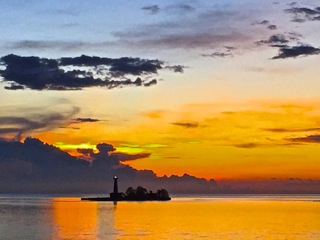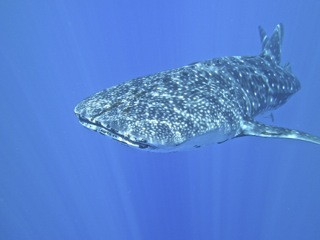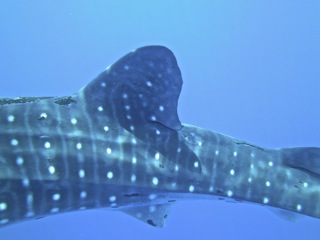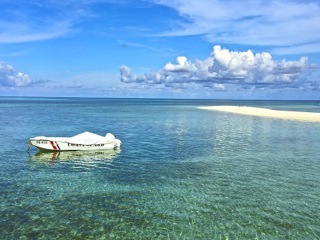Dancing with Whale Sharks
by Lostalley
It’s early afternoon. Standing behind the window of my room at The Bayleaf Hotel, I feel the floor shaking slightly, as if I was still on the swinging dive boat, or under wavy Sulu Sea. Manila Bay at distance looks like a deformed mirror, reflecting sunbeam back to the patchy sky. The city skyline is wrapped in a mirage, under the scotching sun. Bikers, runners and students in uniforms, crawl in slow motion as a vaporized snake, along the aged wall of historical Fort Santiago. The scenery seems surreal. Am I hallucinating?
I’ve dived before, in Great Barrier Reef of Australia, the Caribbean (Belize, Grand Cayman and Bahamas), Galapagos, Indonesia, Thailand. Each merits in their own right. However, Palawan of Philippines is special. I was struck by an uncommon beauty of wilderness, and a laissez-faire attitude of the local diving community, devoid of fuss and hassle in other destinations, propagated by PADI, an over-regulated and over-commercialized cottage industry. And I got lucky. Stella Maris, with a normal capacity of twenty divers, only carried a half load this time. So, ten of us enjoyed a royal treatment, tended by a 20-member crew, as if aboard a private yacht. From Tubbataha Marine Park (a UNESCO World Heritage Site), via Cuyo Island, to Apo Reefs, along a sea lane stretching some 300 nautical miles, for eight days, four dives a day, we have dived with no other boats in sight. The solitude under 28-30 degree (celsius) warm and crystal-clear water breeds awakening, appreciation, and acclamation of a pristine paradise only exiting in fairy tales.


Marine diversity here exceeds my expectation. I am not a micro person. Macro is my game. With due respect to miniature creatures, numerous and hard to remember, I focused on the sizable, such as giant turtle, manta ray, marble ray, eagle ray, sting ray, reef shark, hammer-head shark, tiger shark, a variety of big fish, and dolphin. However, the heyday belongs to the second dive of the second day, when two whale sharks suddenly appeared from nowhere. My adrenaline shot up at sight of them. Rommel, the dive master, first spotted them at a depth of 60 meter and immediately went down to chase them up. I followed him to 54 meter deep to a halt, when my dive computer started beeping to warn me (50 meter is the limit for recreational diving). Miraculously, one whale shark surfaced and swam towards us. My heart started to jump fast. I kicked as hard as I could to get close. At one point, the gigantic shark passed under my belly, so close that I could see tiny parasites clustered on its dotted back. I tried to keep pace with it atop, as a proud captain riding a triumphant submarine. The whale shark was equally curious. It checked us playfully, circling around, cutting through, leaving and returning, like a mischievous child. Another whale shark joined later. The pair stayed with us, gentle and graceful, for well over 40 minutes. Awed and elated, I stayed underwater until my air was used up, and I ascended without the safety stop (3-minute stop at 5 meter deep for decompression). A truly mesmerizing encounter with such magnificent creatures.






Quiminatin Island had strong undercurrent and we did drift diving. Rommel lead me into a secret cave he kept to himself. The entrance is 35 meter deep but the exit at 20 meter. The cave has different layers with several chambers connected by narrow passages. Gingering through the cave in pitch dark, navigated with flash light, is a humbling experience. When exiting, a wing of batfish flew past from behind. How long had they followed me? Why did they choose to pass me at the end of the tunnel? Did they fear or ignore me? These questions are better left unanswered. To imagine is to regain innocence.
Some of the best dive sites in Palawan are named after domestic appliances and public facilities. For instance, “Washing Machine” tends to have strong currents; “Shark Airport” features sleeping sharks at bottom; “Seafan Alley” showcases a strait lined with fan-like coral trees. “South Park” means the site is south of the marine park. Philippine oceanographers must have watched too many Hollywood movies. “Ranger Station”, however, implies a political connotation that goes far beyond recreational diving. In August of 2014, twelve Chinese fishermen were arrested here for catching some 300 endangered giant turtles and subsequently incarcerated in a Palawan prison. We visited “Ranger Station”. This Philippine Coast Guard outpost is minimally equipped. The six-member crew, armed only with a small boat and outdated communication equipment, were friendly. I later checked the map and found “Ranger Station” is within the disputed area Philippines and China have overlapping territorial claims. This afternoon, I was reading Philippine Star, the English daily, over lunch in the rooftop restaurant of The Bayleaf Hotel. Two headliners on the front page caught my eyes: “A Federal Judge Order Palawan Court to Release Chinese Fishermen”; “American Aid of 18 Million to Enhance Philippine Navy to Fend Off China”. I feel ambivalent, but the prospect that light may soon shed into the dark prison cells in which twelve Chinese fishermen have been languishing for almost a year offered residual comfort. A wild but not erratic idea crossed my mind: all claimants of South China Sea can form a consortium with China in lead to develop scuba-diving business in disputed territories. For the namesake, South China Sea deserves Chinese diving boats, and I will sign up in a heart beat.


Today is my last day in Manila. I walk out of the hotel, for a random peek. Three boys beg for money in front of Cioccolata Cafe, an upscale bakery. Basic Kitchen, a fashionable bistro, is filled with chic young men and women at lunch break. A few steps away, shabby street vendors peddle cheap souvenirs, snacks and dubious jewelry to unsuspecting tourists. Behind them is a succession of slums. Separation between poverty and prosperity is paper thin. Today’s stark contrast lays bare, reminiscent of yesterday’s brutal caste system Spanish colonialists imposed here but nowhere else in their empire. A few blocks from The Bayleaf Hotel is Bahay Isinoy, Museum of Chinese in Philippine Life. Chinese Diaspora, mostly made of Guangdong and Fujian migrants, in Philippines, and Southeast Asia to a larger extent, created trade and financial infrastructure and became economic backbone of the guest countries they live in. They’ve done so by going through such injustice, discrimination and hostility that word “inhumane” pales in comparison to the reality. Yet, they survived and even flourished. History is a source of knowledge, but more importantly, a reckoning with oneself. Many years ago, I read《Sons of Yellow Emperor—Chinese Diaspora in Southeast Asia》by Lynn Pan. She has made an invaluable contribution to the understanding of millions of Chinese overseas.


Philippines is a country still haunted by colonial legacy, systemic corruption and dysfunction, domestic terrorism and talent drain. Life for a population of nearly 100 million thriving on the archipelagos of 300, 000 square kilometer is often double crossed by natural catastrophe and human calamity. Seemingly a people of pessimism, Filipinos are also resilient. Ocean molds their character and holds the key to the destiny for the mestizos of the Indigenous, Malay, Chinese, Hindu, Arab, Polynesian, Spanish, English, Japanese and African.
I disembarked Stellar Maris this morning in Batangas, a small seaside town of three-hour drive from Manila. Rommel carried my luggage ashore. I thanked him for his caring and informative assistance, and shook his hand with a hefty tip. He seemed surprised but smiled broadly. A second-generation Filipino with a father from Beijing and a native mother, Rommel is still a Sangley, in the eye of the racist caste under Spanish colonial rule. To me, he is a Pinoy.
Joyce, a young fertility doctor from Shanghai, was in tears when waving a good-bye to the crew who got up at dawn to see us off. “Would you be tempted to make baby whale sharks in future?” I joked. She didn’t answer but laughed heartily.
June 19, 2015, Manila



